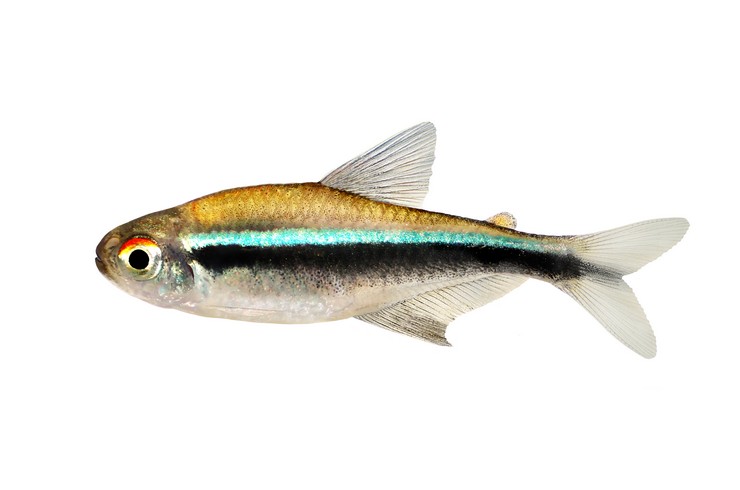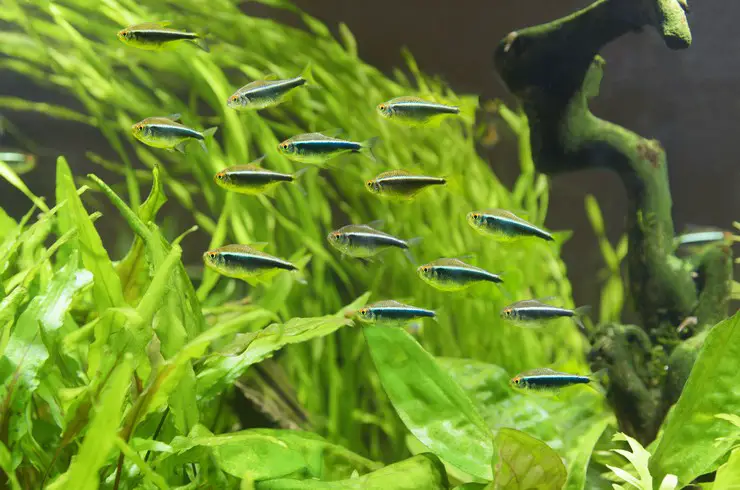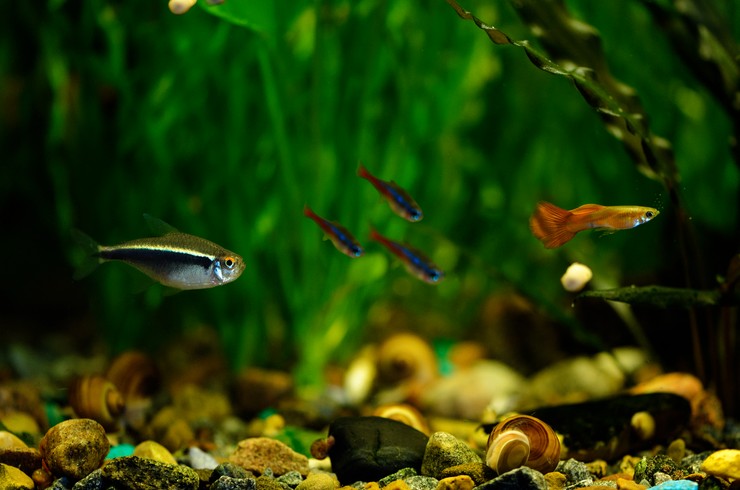Neons are one of the most popular inhabitants of the aquarium. A characteristic feature of these fish is a shiny strip along the body, flashing in the reflected light like advertising neon lights on the streets of a night city. For this, the fish got their name.
General information
Black neon (Hyphessobrycon Herbertaxelrodi) is a member of the Kharacin family. This beautiful and active fish can decorate any tropical aquarium. Prefers to stay in the upper and middle layers of the aquarium. They look especially impressive in aquariums with dark grounds and a large number of aquarium plants. It is worth noting that black neons are not harmful to aquarium gardens, which is why they are often found in designer aquariums.
Black neons are schooling fish with a calm temperament. The name of the genus can be translated as “little biters”, and the species itself is named after the famous American researcher Dr. Herbert Axelrod.
First became available to aquarists since the 60s of the XX century. For a long time they were caught in nature, but now they are massively bred on special fish farms.
Appearance
Black neon has a low, slightly flattened on the sides and elongated body. The length does not exceed 4 cm. The abdomen is silvery, the back is olive. On the sides of the body, from the gill covers to the tail, two stripes stretch. The bottom one is wide, with a blurred bottom edge, painted black, the top one is narrow, shiny, with a bluish tint. This strip contains special pigment cells with high reflectivity, which is why it “flashes” in reflected light. The tail is bilobed, transparent. The rest of the fins are also transparent or with a slight yellow tint. An adipose fin is present. The upper part of the iris is colored red.
Gender dimorphism is not pronounced. Females are larger, with a more rounded abdomen.
Life expectancy is 5-10 years.
Habitat
In nature, black neon is widespread in the rivers of Brazil, Paraguay, and Bolivia. It was first described in 1961, then it was brought to Europe, where it gained great popularity.
Typical habitat for black neon is streams, small rivers, flooded forests, and sandbanks under the canopy of the rainforest. The water in such reservoirs is soft and acidic. A large amount of decaying plant residues colors it in rich brown color.
Care and maintenance
Black neons feel most comfortable in flocks of 10 or more individuals. For such a number of fish, you will need an aquarium of at least 60 liters. It should be equipped with a lid because fish can easily jump out of the aquarium.
It is best to use black sand or dark small pebbles as a substrate. Fish look good in aquariums with live plants and natural decorations (driftwood, stones). To maintain high water quality, effective filtration and aeration are required, and the flow should be moderate. Do not get carried away with bright lighting, black neons prefer subdued light. Plants floating on the surface (pistia, riccia) can help with this. Fish are thermophilic, so a thermostat must be placed in the aquarium.
Neons do not tolerate planting in fresh, unsettled aquariums very badly, it is advisable to start them in the aquarium after a few months from the date of launch. To create a natural environment in the aquarium, it is recommended to use Tetra ToruMin, a natural peat extract that will create a black water effect. To reduce nitrate and phosphate levels, regular water changes are needed – up to 25-30% of the aquarium.
It is advisable to have a large number of live plants in the aquarium with black neons. You can pay attention to such species as Echinodorus, Cryptocoryne, Ceylon fern.
Compatibility
Black neons are a great choice for a community aquarium with peaceful tropical fish. When kept in a flock, the fish are active and absolutely harmless. Good neighbors will be danios, rasbora, gourami, lalius, corridors, ancistrus, tetras. As for the content with shrimps, not everything is clear. Aquarists note that in some cases the fish are absolutely indifferent to invertebrates, while in others they can attack young individuals.
Naturally, you cannot contain black neons with large and predatory fish that can feast on shiny neighbors.
Feeding black neons
In their natural environment, black neons feed on small crustaceans, as well as insects and mosquito larvae. When keeping in an aquarium, it is better to give preference to quality dry food in the form of flakes, chips, or small granules. The use of live and frozen food carries the risk of contaminating the aquarium with dangerous infections and parasites and does not contain the full range of nutrients and vitamins, not to mention difficulties in storage.
Black neons prefer to eat food from the surface or in the water column. The following feeds have proven themselves well:
- TetraMin is a mixture of 7 flakes made from more than 40 ingredients. It has been the most popular dry fish food for decades. Fully balanced contains vitamins and probiotics. Due to the high digestibility of the feed, the amount of fish waste is reduced and the purity of the feed is ensured.
- TetraPro Energy is highly nutritious food in the form of chips, made using gentle low-temperature technology, which allows you to retain even more nutrients in the feed. At the center of the chips is an energy concentrate so that the neons are always active.
- Tetra Micro Granules are mini granules specially designed for fish with small mouths. The balanced formula combines plant and animal ingredients.
Don’t forget to diversify your pets’ menu with natural treats in jelly – Tetra FreshDelica. Your fish will appreciate the nutritious jelly flavor with popular food sources such as bloodworms, brine shrimp, daphnia, and krill.
Reproduction and breeding
Reproduction of black neon is not very difficult, but some practice is still required.
To begin with, good producers are selected: one female and two or three males. A week before the expected spawning, they are seated and abundantly fed with high-protein food. When the female’s belly is noticeably rounded, it’s time to place the fish in a separate spawning aquarium. For this, a container of 20-30 liters with a water level of about 20 cm is suitable. The water in the spawning box should be soft and acidic (GH <4, pH = 5.5-6.5). A net is laid at the bottom, and small-leaved plants are placed on top. It is also necessary to install a weak filter with aeration.
Spawning occurs 1-3 days after placing the fish in the aquarium. This usually happens at dawn. The fecundity of a female can be up to 200 eggs. After fertilization, they fall to the bottom and attach to the leaves of aquatic plants. After the end of the process, the producers must be deposited so that they do not feast on their own eggs. The aquarium should be darkened on three sides, as the eggs are light sensitive.
Incubation takes 24-36 hours, the larva becomes independent on 3-5 days. Water changes in the spawning grounds should be done more often.
Growth in fry is fast; by the third week of life, characteristic longitudinal stripes appear on the body. Fish become pubertal at 8-11 months.

